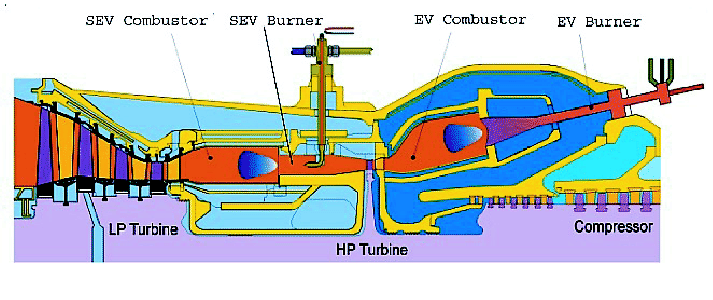 |
|
|
|
[Contents] | [Index] |
Collaborator: J. Borchardt, F. Grund, D. Horn
Cooperation with: D. Zeitz (ALSTOM (Switzerland) Ltd., Baden)
Supported by: ALSTOM (Switzerland) Ltd., Baden
Description:
In today's gas turbine engineering, it is not only needed to increase the capacity and the efficiency of the turbines, but also to reach the highest possible reliability and to ensure a safe, economic, and environmentally acceptable operation of heavy duty industrial turbines. In modern gas-fired combined-cycle power stations, a new generation of advanced gas turbines (Figure 1) is used. These turbines use the sequential combustion technology. With this technology, the fuel is injected twice into the gas turbine, and the capacity and efficiency are increased without increasing the fire temperature. Power augmentation can be achieved, among other things, by inlet cooling and high fogging. The processes which proceed within these turbines are highly integrated, leading to complex and highly nonlinear process models. In this context, large-scale process simulation problems may arise. Using concentrated physical models, high-dimensional systems of nonlinear or differential-algebraic equations (DAEs) have to be solved in steady state or dynamic process simulation, respectively. For their solution, robust, fast, and reliable numerical simulation tools are needed.
To handle those large-scale process simulation problems, we have
developed a simulation approach that is based on ``divide and conquer''
techniques. Within this approach, the modular structure of the process
is exploited for an efficient numerical solution of the resulting
equation system. Because the modular process structure corresponds to
the hierarchical unit structure of the underlying plant, the
corresponding system of equations can be structured into subsystems
according to the units. Based on this structure, it can then be
portioned into blocks
| Fj(t, Yj(t), |
The approach has been implemented in the Block
Oriented Process simulator BOP
[2] that uses an own compiler to
generate a hierarchically structured data interface from a process
description with its modeling language MLPE (Modeling Language for
Process
Engineering).
In the period under report, we have continued our cooperation with ALSTOM (Switzerland) Ltd., a leading gas turbine producer. We have delivered BOP Version 2.0 to ALSTOM, where the simulator is now used for the process simulation of industrial gas turbines. It runs under the Windows XP operating system on PCs, where it is called by ALSTOMs graphical user interface ALPEG. Compared to the previous version, Version 2.0 of BOP contains a number of new features. Among other things, it enables a binary input/output and a direct data transfer between the Java GUI and the simulator via the Java Native Interface (JNI) and a dynamic link library. The scope of the process description possibilities has been considerably extended. The combination ALPEG-BOP is now in successful business use. Different versions of this simulation tool can be used by process designers or sells managers, respectively.
In continuation of this work and based on a new license agreement with ALSTOM, we have started the development of BOP Version 2.1. In this context, we have made changes to the control strategy of the steady state solver within BOP to improve its reliability and performance even in critical regions of the modeling, as, e.g., for the problem of anti-icing and the problem of discontinuous modeling with respect to the turbine operation at low part-load. Competitive simulation runs for those critical problems have shown that BOP still converges where the Aspen Custom ModelerTM (ACM), a worldwide leading commercial simulation tool of Aspen Technology (USA), fails.
Additionally, we continued the implementation of advanced elements of the modeling language of ACM, whose functionality goes far beyond the scope of MLPE. With it, we have considerably enlarged the application area of BOP. These achievements will finally make it possible to use BOP for the simulation of processes described with the modeling language of ACM, without the necessity to make extensive changes in the process description. The realized language extension covers in particular complex IF-statements which can contain multiple instructions as well as procedure calls, the usage of different actions if a variable is fixed or free, the possibility of defining a new model by extending or modifying an existing one, and the possibility to include source code from a library. Beside this, new standard functions have been implemented and it is now possible to use integer, string, and logical parameters as well as global parameter-type definitions. All these new language elements can now be treated by our three-step compiler, which first analyzes the process description statements, then links the entire system, and finally generates the data and the program interface to the BOP solver. Their practicability has been tested for process descriptions of different industrial gas turbines.
Finally, we have written a documentation [2] for BOP.
For the near future it is planned to add a Monte Carlo simulation mode to the simulator BOP. It should enable probabilistic statements about the process, as, e.g., probability curves for engine power, engine efficiency, or engine exhaust energy.
References:
|
|
|
[Contents] | [Index] |